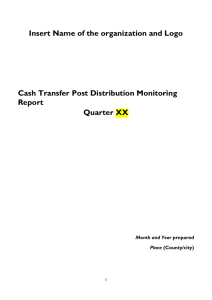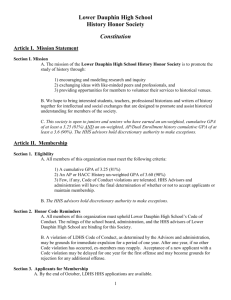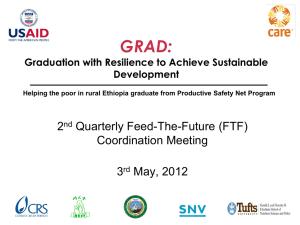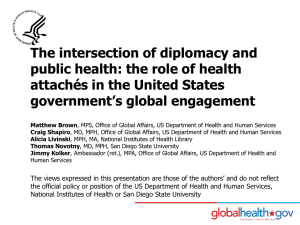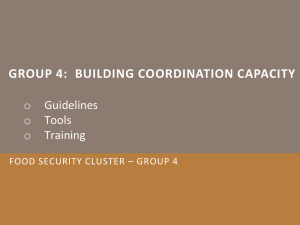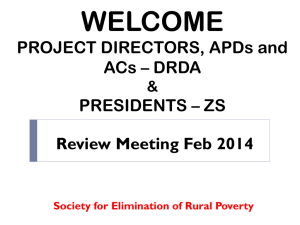PowerPoint-presentatie - Food Security Clusters
advertisement
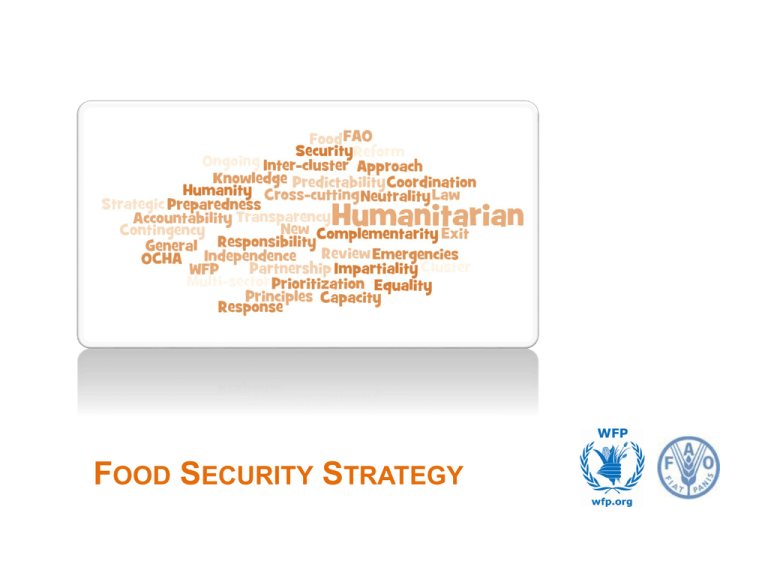
FOOD SECURITY STRATEGY FOOD SECURITY STRATEGY LEARNING OBJECTIVES 1. Understand the importance and methods of coordinating joint planning and strategy in the Food Security Cluster 2. Identify and understand the concepts and common principles behind short and long term food security strategies Food Security Strategy 2 FOOD SECURITY STRATEGY RELEVANCE Why is this subject covered? The development of a coherent, agreed upon sectoral strategy for a food security response is one of the most important functions of the cluster. A general knowledge of food security concepts will help in this development. How does this relate to my day to day tasks? Using data from joint or coordinated assessments, cluster staff help guide cluster partners in the production of a food security strategy document Food Security Strategy 3 FOOD SECURITY STRATEGY – WHY IMPORTANT? Food Security Strategy 4 FOOD SECURITY CLUSTER- TOR Guidance for Coordination Actions Coordinated What does the FSC do? 1. Ensure predictable and accountable leadership 2. Represent the food security community in the different country level fora 3. Support coordination in assessment planning and response, strategy 4. Develop benchmarks and indicators 5. Advocacy for entire food security community, not just specific partners 6. Strengthen national/local systems 7. Ensure quality of response, promotion of appropriate standards and delivery of services 8. Ensure shared understanding of early recovery 9. Learn and build upon best practices 10. Ensure partnership and inclusiveness Food Security Strategy 5 COORDINATED FOOD SECURITY STRATEGY– WHAT IS IT? Assessment Findings & Situation Analysis (Prioritized Problems, Risks, and Gaps) Set of Programmatic Response Plans to Meet Objectives Set of Objectives and targets • • • • Appropriate Feasible Underlying Causes Cross-cutting issues Individual Organizations Project Planning, Implementation and Monitoring Food Security Strategy 6 FOOD SECURITY STRATEGY– DELIVERABLES 1st week ~2 months Preliminary Scenario Definition Initial Assessments and Analysis New Assessments Preliminary Response Strategy Outline More Detailed Response Strategy Document Updates to Strategy Document Food Security Strategy As required Monitoring 7 COORDINATED FOOD SECURITY STRATEGY – WHY AND HOW Why? ‘ensuring…effective cluster and inter-cluster coordination through collective planning of assessments and response’ • Support coordination in assessment planning, response, and strategy • Develop benchmarks and indicators • Strengthen national/local systems • Ensure understanding of early recovery • Ensure partnership and inclusiveness How? Ensure Partnership & Inclusiveness Support Coordination, Ensure Quality/Standards, Develop Benchmarks & Indicators • • • • • IM: Analysis dissemination Push for agreement on objectives, linked to problems Guide evaluation of strategy/response alternatives Guide benchmark/indicator development (Cross-cutting) Consolidate and prepare doc Food Security Strategy • • Identify key entities for inclusion Optimize complement. Strengthen Nat’l Systems / Early Recovery • • • • Involvement Training/ass istance Recovery Twin-Track 8 FOOD SECURITY STRATEGY DEFINITION “…Food Security exists when all people, at all times, have physical, social and economic access to sufficient, safe and nutritious food to meet their dietary needs and food preferences for an active and healthy life.” Four pillars of food security: 1 AVAILABILITY Physical presence /proximity of food through domestic production or imports Food Security Strategy 2 ACCESS Physical, social, and economic access to enough food to meet needs. 3 UTILIZATION Use of food through adequate diet, WASH, etc. to reach nutritional well-being (non-food input) 4 STABILITY Consistency and reliability in food supply 9 FOOD SECURITY STRATEGY FRAMEWORKS Livelihoods Nutrition Food and Nutrition Security Food Security Strategy Food Security Strategy 1 AVAILABILITY Physical presence / proximity of food through domestic production or imports 2 ACCESS Physical, social, and economic access to enough food to meet needs. 3 UTILIZATION Use of food through adequate diet, WASH, etc. to reach nutritional well-being (non-food input) 4 STABILITY Consistency and reliability in food supply 10 AVAILABILITY Physical presence /proximity of food through domestic production or imports STABILITY Consistency and reliability in food supply ACCESS Physical, social, and economic access to enough food to meet needs. UTILIZATION Use of food through adequate diet, WASH, etc. to reach nutritional wellbeing (non-food input) A FOOD SECURITY SYSTEM A SET OF INTERDEPENDENT SUB-SYSTEMS (PILLARS) “Rethinking Food Security in Humanitarian Response,” Maxwell, Webb, Coates, Wirth, Food Security Forum, Rome, 2008. • Meeting (closing the gap in) minimum current food and non-food consumption needs • Stabilizing consumption into the medium term • Laying the ground for enhanced future consumption in terms of quality, not only quantity • Repairing or replacing the local stock of damaged/lost productive assets • Enhancing the productivity of current assets • Repairing or enhancing impaired income streams (which may involved enhancing human capital to achieve higher labor productivity) • Make diversification of future income streams more feasible Strategy 11 • Food HelpSecurity buffer assets and income from a range of potential future hazards STRATEGIC RESPONSE FRAMEWORK Objectives: mitigate immediate FS problems, support livelihoods, address causes: focus on 1. 2. 3. 4. food consumption livelihood change nutrition mortality Food Security Strategy 12 OVERALL FSC OBJECTIVES? • • • • Improve access to food Institute seed distribution programs to address food availability concerns Improve food utilization at household level Improve nutritional status Food Security Strategy 13 OUTCOME: IMPROVED FOOD CONSUMPTION Among targeted population: 1. Quantity: X kcal pp/day 2. FCS: poor/borderline: <X% hhs 3. HHS: moderate/severe (scores 2-6): <X% 4. HDDS: <4 food group (out of 12 food groups)s: <X% 5. HEA: <Livelihood Protection Deficit: <X% Food Security Strategy 14 OUTCOME: LIVELIHOOD CHANGE Enhanced productivity of current assets (Livelihoods protected: drought impact on HHs incomes limited/source of nutrient food provided:) Indicators for targeting: 1. Reduced animal mortality rates, 2. reduction of livestock distress-selling 3. livestock productivity preserved Food Security Strategy 15 OUTCOME: IMPROVED NUTRITIONAL STATUS Among targeted population: 1. Stunting: X – Y% 2. BMI <X: Y--Z% 3. Anemia : <X% 4. Vitamin A deficiency: <X% Food Security Strategy 16 IMPROVED ACCESS TO FOOD Outputs: Vulnerable targeted HHs in country and vulnerable HH’s receive sufficient basic food commodities and other relevant assistance to cover their requirements and establish a food secure environment. Indicators for targeting: • # households receiving assistance • # of beneficiaries receiving assistance (disaggregated by gender) • # MT of food commodities distributed • # of cycles of distribution completed in a timely manner • % of beneficiary households compliant with targeting criteria Food Security Strategy 17 FOOD SECURITY STRATEGY – EXAMPLES (PAKISTAN) Food Security Strategy 18 FOOD SECURITY STRATEGY-LIBYA (EXAMPLE) • Food assistance to vulnerable groups including those displaced from the conflict zones and those with traditional vulnerability profiles such as orphans, elderly and single parent households to ensure their immediate food needs are met. Food Security Strategy 19 FOOD SECURITY STRATEGY EXERCISE Using “situation analysis” outline from Assessment and Analysis Module: 1. Develop 3-4 Food Security Cluster strategic objectives that respond to the prioritized problems identified in the morning. (refer to the IPC and the phase you identified) 1. Present to the group Use Pakistan or Libya Handout as a guide Food Security Strategy 20 FOOD SECURITY STRATEGY RELEVANCE Why is this subject covered? The development of a coherent, agreed upon sectoral strategy for a food security response is one of the most important functions of the cluster. A general knowledge of food security concepts will help in this development. How does this relate to my day to day tasks? Using data from joint or coordinated assessments, cluster staff help guide cluster partners in the production o Food Security Strategy 21 FOOD SECURITY STRATEGY KEY MESSAGES • Food security is composed of availability, access, utilization, and stability • Food security strategies have multiple goals but all seek to address the pillars of FS. • The FSC must recognize the different focuses of varying strategy frameworks • The Cluster coordinator must facilitate cluster strategy planning, linking problems to results, and results to strategies. Food Security Strategy 22 KEY REFERENCE OUTCOMES: IPC • • • • • • • • • Crude Mortality Rate Acute Malnutrition Disease Food Access / Availability Dietary Diversity Water Access / Avail. Destitution / Displacement Civil Security Coping Livelihood Assets Assessment and Analysis • • • • p/d; U5MR % w/2z score Epidemic; pandemic Entitlement gap; 1200 kc/pp/pd • Liters pp/pd • • • • emerging; concentrated Conflict level Strategy type Stress levels FOOD SECURITY OUTCOME INDICATORS (NATF Operational Guidance) • % HHs according to food consumption score • % HHs by duration of food stock • % HHs by coping strategy index • % HHs by main source of staple consumed • % HHs with less than 3 meals daily for children • % HHs with less than 2 meals daily for adults • % HHs without physical access to any markets • % markets by level of decreases in availability of staples • % markets with price of staple foods increased by 20% • % HHs by main income source • % HHs by main type of cash expenditures • Average daily casual labor wage • % HHs receiving food assistance, by type • % HHs receiving cash/vouchers Food Security Strategy 24 OUTCOMES: PROTECTION OF LIVES, REDUCTION OF HUNGER Overall FSC Outcomes: “…Save lives and avert hunger amongst vulnerable flood-affected populations and stabilize and/or improve the nutritional status of affected women and children.” Food Security Strategy 25 Outcome: Lives saved and hunger averted…amongst vulnerable floodaffected populations and nutritional status of affected women and children stabilized/improved. Indicators: 1. Reduced MAM amongst screened cases in flood-affected areas, measured by the mid-upper arm circumference (MUAC) 2. Improved food consumption over the assistance period for targeted flood-affected HHs, (HH Food Consumption Score-FCS) 3. 110,000 moderately acute malnourished children and 86,000 moderately acute malnourished pregnant and lactating women treated Food Security Strategy 26
